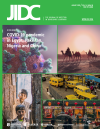Hypocalcemia in sepsis: analysis of the subcellular distribution of Ca2+ in septic rats and LPS/TNF-α-treated HUVECs
DOI:
https://doi.org/10.3855/jidc.12341Keywords:
Sepsis, Hypocalcemia, Calcium overload, Subcellular Redistribution, MechanismAbstract
Introduction: Hypocalcemia has been widely recognized in sepsis patients. However, the cause of hypocalcemia in sepsis is still not clear, and little is known about the subcellular distribution of Ca2+ in tissues during sepsis.
Methodology: We measured the dynamic change in Ca2+ levels in body fluid and subcellular compartments, including the cytosol, endoplasmic reticulum and mitochondria, in major organs of cecal ligation and puncture (CLP)-operated rats, as well as the subcellular Ca2+ flux in HUVECs which treated by endotoxin and cytokines.
Results: In the model of CLP-induced sepsis, the blood and urinary Ca2+ concentrations decreased rapidly, while the Ca2+ concentration in ascites fluid increased. The Ca2+ concentrations in the cytosol, ER, and mitochondria were elevated nearly synchronously in major organs in our sepsis model. Moreover, the calcium overload in CLP-operated rats treated with calcium supplementation was more severe than that in the non-calcium-supplemented rats but was alleviated by treatment with the calcium channel blocker verapamil. Similar subcellular Ca2+ flux was found in vitro in HUVECs and was triggered by lipopolysaccharide (LPS)/TNF-α.
Conclusions: Ca2+ influx from the blood into the intercellular space and Ca2+ release into ascites fluid may cause hypocalcemia in sepsis and that this process may be due to the synergistic effect of endotoxin and cytokines.
Downloads
Published
How to Cite
Issue
Section
License
Authors who publish with this journal agree to the following terms:
- Authors retain copyright and grant the journal right of first publication with the work simultaneously licensed under a Creative Commons Attribution License that allows others to share the work with an acknowledgement of the work's authorship and initial publication in this journal.
- Authors are able to enter into separate, additional contractual arrangements for the non-exclusive distribution of the journal's published version of the work (e.g., post it to an institutional repository or publish it in a book), with an acknowledgement of its initial publication in this journal.
- Authors are permitted and encouraged to post their work online (e.g., in institutional repositories or on their website) prior to and during the submission process, as it can lead to productive exchanges, as well as earlier and greater citation of published work (See The Effect of Open Access).








